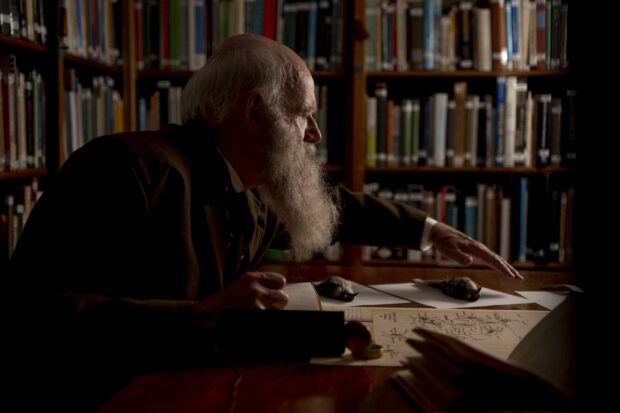
 US Kenneth Noll, in the costume of the English naturalist, geologist, and biologist Charles Robert Darwin, writes inside a library during an interview with AFP in Puerto Ayora on Santa Cruz Island in Galapagos, Ecuador, on September 28, 2023. After 188 years, Charles Darwin returns to the Galapagos Islands, but in the role of Kenneth Noll, a former US microbiology professor who became obsessed with the English naturalist and landed in the archipelago to visit this unique place in the world. (Photo by Carlos ESPINOSA / AFP)
US Kenneth Noll, in the costume of the English naturalist, geologist, and biologist Charles Robert Darwin, writes inside a library during an interview with AFP in Puerto Ayora on Santa Cruz Island in Galapagos, Ecuador, on September 28, 2023. After 188 years, Charles Darwin returns to the Galapagos Islands, but in the role of Kenneth Noll, a former US microbiology professor who became obsessed with the English naturalist and landed in the archipelago to visit this unique place in the world. (Photo by Carlos ESPINOSA / AFP)
PUERTO AYORA, Ecuador — As Charles Darwin did in 1831, a group of scientists and environmentalists last year set sail from the English port of Plymouth, headed for the Galapagos islands off the coast of Ecuador.
But what they found on their arrival last month differed vastly from what naturalist Darwin saw while visiting the archipelago in 1835, in a trip key to developing his world-changing theory on natural selection.
The Galapagos today is under protection, part of a marine reserve and classified a World Heritage Site. Yet the area faces more threats than ever, from pollution and illegal fishing to climate change.
Article continues after this advertisementREAD: Ship sets sail from England to retrace Charles Darwin’s voyage nearly 200 years later
FEATURED STORIES TECHNOLOGY vivo launches V40 Lite with 5000mAh battery covered by 50-month warranty, starts at Php 13,999 TECHNOLOGY Galaxy Buds3 Pro: Delivering tailored sound wherever you go TECHNOLOGY Very mindful, very intuitive: ASUS’ most superior AI PC yet, the Zenbook S 14, empowers you to achieve moreThere to observe the challenges, with a well-thumbed copy of her great-great-grandfather’s “On the Origin of Species” in hand, was botanist Sarah Darwin.
“I think probably the main difference is that, you know, there are people working now to protect the islands,” the 60-year-old told AFP, onboard the “Oosterschelde,” a refurbished, three-mast schooner built more than 100 years ago.
Article continues after this advertisementThe ship has been on a scientific and awareness-raising expedition since last August, stopping so far in the Canary Islands, Cape Verde, Brazil and Chile among other locales.
Article continues after this advertisement Darwin’s ‘heirs’In colonial times, the islands – located in one of the world’s most biodiverse regions – served as a pit stop for pirates who caught and ate the giant turtles that call it home.
Article continues after this advertisementDuring World War II, the archipelago hosted a US military base.
“I think if (Darwin) were able to come back now and see the efforts that everybody is making, both locally and globally, to protect these extraordinary islands and that biodiversity – I think he’d be really, really excited and impressed,” the naturalist’s descendant told AFP.
Article continues after this advertisementSarah Darwin first visited the Galapagos in 1995, where she illustrated a guide to endemic plants. She then devoted herself to studying native tomatoes.
She also mentors young people as part of a project to create a group of 200 Darwin “heirs” to raise the alarm about environmental and climate threats to the planet.
READ: New coral reef discovered in Ecuador’s Galapagos Islands
Calling at several ports on the journey from Plymouth to the Galapagos, the Oosterschelde took on new groups of young scientists and activists at every stop, and dropped off others.
One of them, Indian-born Laya Pothunuri, who joined the mission from Singapore, told AFP the Galapagos “has a very important place in scientific terms.”
She was there, she said, to improve the irrigation systems in the islands’ coffee-growing regions.
“I plan to do it using recycled plastic, which also, again, is a big problem over here,” she said, noting that plastic waste ends up being consumed by wildlife.
Plastic perilIn the Galapagos, the expedition members worked with researchers from the private Universidad San Francisco de Quito, Charles Darwin Foundation, and Conservation International on both confronting invasive species and protecting endemic ones.
Last year, a study by the Charles Darwin Foundation found that giant turtles in the area were ingesting harmful materials due to human pollution.
Samples revealed that nearly 90 percent of the waste consumed was plastic, eight percent was fabric and the rest metal, paper, cardboard, construction materials and glass.
Subscribe to our daily newsletter
From Galapagos, the Oosterschelde set sail again on Sundaybetsafe casino, May 26, to continue its world tour, with stops expected in Tahiti, New Zealand, Australia, and South Africa.
TOPICS: Charles Darwin, Galapagos READ NEXT OpenAI says AI is ‘safe enough’ as scandals raise ... ChatGPT voice removed due to sounding like Scarlett Johansson EDITORS' PICK Manila Water Foundation and partners underscore benefits of handwashing NBA: Nuggets give Aaron Gordon 4-year, $133M extension Kristine gets nearer; Metro Manila, 42 other areas under Signal No. 1 SC issues TRO vs Comelec resolution on dismissed public officials UPDATES: 2025 elections precampaign stories WPS: US missile deployment to PH key for combat readiness – US general MOST READ SC issues TRO vs Comelec resolution on dismissed public officials Tropical Storm Kristine slightly intensifies; Signal No. 2 in 5 areas Walang Pasok: Class suspensions on Wednesday, Oct. 23 LIVE UPDATES: Tropical Storm Kristine View comments
